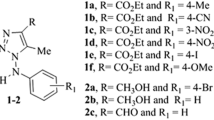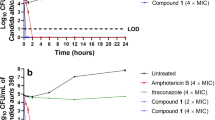Abstract
Imidazoles are a category of azole antifungals that encompass compounds such as ketoconazole, miconazole, esomeprazole, and clotrimazole. In contrast, the triazoles group, which includes fluconazole, voriconazole, and itraconazole, also plays a significant role. The rise of antibiotic resistance in fungal pathogens has evolved into a substantial global public health concern. In this study, two newly synthesized imidazo[1,2-a]pyridine derivative (Probe I and Probe II) molecules were investigated for its antimicrobial potency against of a panel of bacterial (Gram-positive and Gram-negative bacteria) and fungal pathogens. Among the different types of pathogens, we found that Probe II showed excellent antifungal activity against fungal pathogens, based on the preliminary screening the potent molecule further investigated against multidrug-resistance Candida sp. (n = 10) and compared with commercial molecules. In addition, in-silico molecular docking, its dynamics, absorption, distribution, metabolism, excretion and toxicity (ADMET) were analyzed. In this study, the small molecule (Probe II) displayed potent activity only against the Candida spp. including several multidrug-resistant Candida spp. Probe II exhibited minimum inhibitory concentration ranges from 4 to 16 µg/mL and minimum fungicidal concentration in the range 4‒32 µg/mL as the lowest concentration enough to eliminate the Candida spp. The selected molecules inhibit the formation of yeast to mold as well as ergosterol formation by the computational simulation against Sterol 14-alpha demethylase (CYP51) and inhibition of ergosterol biosynthesis by in-vitro model show that the Probe II completely inhibits the formation of ergosterol in yeast cells at 2× MIC. The ADMET analysis Probe II could be moderately toxic to the human being, though the in-vitro toxicity studies will help to understand the real-time toxic level. The novel compound Probe II, which was synthesized during the study, shows promise for development into a new generation of drug treatments aimed at addressing the emerging drug resistance in Candida sp.












Similar content being viewed by others
Data availability
The data that support the findings of this study are available on request from the corresponding author Dr. Manivannan Nandhagopal.
Abbreviations
- ADMET:
-
Absorption, distribution, metabolism, excretion and toxicity
- AIDS:
-
Acquired immune deficiency syndrome
- MDR:
-
Multi-drug resistance
- MIC:
-
Minimum inhibitory concentration
- NA:
-
Not appeared
- ND:
-
Not determined
- NC:
-
Negative control
- PC:
-
Positive control
- ZOI:
-
Zone of inhibition
- MFC:
-
Minimum fungicidal concentration
- C1:
-
C. tropicalis (ATCC750)
- C2:
-
C. albicans (KT315910)
- C3:
-
C. tropicalis (KT315910)
- C4:
-
C. albicans (KT315901)
- C5:
-
C. albicans (KT831886)
- C6:
-
Candida Sp. (KT831887)
- C7:
-
C. dubliniensis (KT831888)
- C8:
-
C. albicans (KT831889)
- C9:
-
C. albicans (KT315909)
- Probe I:
-
2-(3-(Tert-Butylamino)imidazo[1,2-a]pyridin-2-yl)phenol
- Probe II:
-
N-(Tert-Butyl)-2-(pyridin-2-yl)imidazo[1,2-a]pyridin-3-amine
- MD:
-
Molecular simulation
- RMSD:
-
Root mean square deviation
- RMSF:
-
Root mean square fluctuation
- MHB:
-
Muller Hinton broth
- MHA:
-
Muller Hinton agar
- CLSI:
-
Clinical & Laboratory Standards Institute
- PBS:
-
Phosphate buffer saline
- PDB:
-
Protein data bank
References
Abrahams KA, Cox JAG, Spivey VL et al (2012) Identification of novel imidazo[1,2-a]pyridine inhibitors targeting M. tuberculosis QcrB. PLoS ONE 7:e52951
Alabi PE, Gautier C, Murphy TP et al (2023) Small molecules restore azole activity against drug-tolerant and drug-resistant Candida isolates. Mbio 14(4):e0047923
Bagdi AK, Santra S, Monir K, Hajra A (2015) Synthesis of imidazo[1,2-a]pyridines: a decade update. Chem Commun 51:1555–1575
Bar-Yosef H, Vivanco Gonzalez N, Ben-Aroya S, Kron SJ, Kornitzer D (2017) Chemical inhibitors of Candida albicans hyphal morphogenesis target endocytosis. Sci Rep 7:5692
Bodedla GB, Justin Thomas KR, Kumar S, Jou J-H, Li C-J (2015) Phenothiazine-based bipolar green-emitters containing benzimidazole units: synthesis, photophysical and electroluminescence properties. RSC Adv 5:87416–87428
Bouchal B, Abrigach F, Takfaoui A et al (2019) Identification of novel antifungal agents: antimicrobial evaluation, SAR, ADME-Tox and molecular docking studies of a series of imidazole derivatives. BMC Chem Biol 13:100
Breivik ON, Owades JL (1957) Yeast analysis, spectrophotometric semimicrodetermination of ergosterol in yeast. J Agri Food Chem 5(5):360–363
Bruder-Nascimento A, Camargo CH, Mondelli AL, Sugizaki MF, Sadatsune T, Bagagli E (2014) Candida species biofilm and Candida albicans ALS3 polymorphisms in clinical isolates. Braz J Microbiol 45:1371–1377
Chin VK, Lee TY, Rusliza B, Chong PP (2016) Dissecting Candida albicans infection from the perspective of C. albicans virulence and omics approaches on host–pathogen interaction: a review. Int J Mol Sci 17(10):1643. https://doi.org/10.3390/ijms17101643
Cui X, Wang L, Lü Y, Yue C (2022) Development and research progress of anti-drug resistant fungal drugs. J Infect Public Health 15:986–1000
Daneshnia F, de Almeida Júnior JN, Ilkit M et al (2023) Worldwide emergence of fluconazole-resistant Candida parapsilosis: current framework and future research roadmap. Lancet Microbe 4:e470–e480
de Oliveira Santos GC, Vasconcelos CC, Lopes AJO et al (2018) Candida infections and therapeutic strategies: mechanisms of action for traditional and alternative agents. Front Microbiol 9:1351
Enguehard-Gueiffier C, Gueiffier A (2007) Recent progress in the pharmacology of imidazo[1,2-a]pyridines. Mini Rev Med Chem 7:888–899
Goel R, Luxami V, Paul K (2016) Imidazo[1,2-a]pyridines: promising drug candidate for antitumor therapy. Curr Top Med Chem 16:3590–3616
Gudmundsson KS, Johns BA (2007) Imidazo[1,2-a]pyridines with potent activity against herpesviruses. Bioorg Med Chem Lett 17:2735–2739
Gueiffier A, Lhassani M, Elhakmaoui A et al (1996) Synthesis of acyclo-C-nucleosides in the imidazo[1,2-a]pyridine and pyrimidine series as antiviral agents. J Med Chem 39:2856–2859
Hashem HE, Amr AE-GE, Nossier ES, Elsayed EA, Azmy EM (2020) Synthesis, antimicrobial activity and molecular docking of novel thiourea derivatives tagged with thiadiazole, imidazole and triazine moieties as potential DNA gyrase and topoisomerase IV inhibitors. Molecules 25:2766. https://doi.org/10.3390/molecules25122766
Iyer KR, Robbins N, Cowen LE (2022) The role of Candida albicans stress response pathways in antifungal tolerance and resistance. iScience 25:103953
Juárez-López D, Schcolnik-Cabrera A (2021) Drug repurposing: considerations to surpass while re-directing old compounds for new treatments. Arch Med Res 52:243–251
Kamli MR, Srivastava V, Hajrah NH et al (2021) Facile bio-fabrication of Ag–Cu–Co trimetallic nanoparticles and its fungicidal activity against Candida auris. J Fungi (basel) 7:62. https://doi.org/10.3390/jof7010062
Mahmoud DE, Faraag AHI, Abu El-Wafa WM (2021) In vitro study on the potential fungicidal effects of atorvastatin in combination with some azole drugs against multidrug resistant Candida albicans. World J Microbiol Biotechnol 37:191
Mala R, Suman K, Nandhagopal M (2019) Chelation of specific metal ions imparts coplanarity and fluorescence in two imidazo [1, 2-a] pyridine derivatives: potential chemosensors for detection of metal ions in in aqueous and biosamples. Spectrochim Acta A Mol Biomol Spectrosc 222:117236
Mayer FL, Wilson D, Hube B (2013) Candida albicans pathogenicity mechanisms. Virulence 4:119–128
Odds FC (1993) Resistance of yeasts to azole-derivative antifungals. J Antimicrob Chemother 31:463–471
Panda SK, Buroni S, Tiwari V, Nascimento da Silva LC (2021) Editorial: insights into new strategies to combat biofilms. Front Microbiol 12:742647
Rahimi-Verki N, Shapoorzadeh A, Razzaghi-Abyaneh M et al (2016) Cold atmospheric plasma inhibits the growth of Candida albicans by affecting ergosterol biosynthesis and suppresses the fungal virulence factors in vitro. Photodiagn Photodyn Ther 13:66–72
Sagatova AA, Keniya MV, Wilson RK, Monk BC, Tyndall JDA (2015) Structural insights into binding of the antifungal drug fluconazole to Saccharomyces cerevisiae lanosterol 14α-demethylase. Antimicrob Agents Chemother 59:4982–4989
Sionov RV, Feldman M, Smoum R, Mechoulam R, Steinberg D (2020) Anandamide prevents the adhesion of filamentous Candida albicans to cervical epithelial cells. Sci Rep 10:13728
Somarathinam K, Gunalan S, Sailapathi A et al (2023) Antihypertensive effects of pentacyclic triterpenoid from Convolvulus pluricaulis and its plausible mechanism of action hypothesizing its selectivity targeting mineralocorticoid receptor of RAAS. Phytomed plus 3:100408
Velusamy P, Das J, Pachaiappan R, Vaseeharan B, Pandian K (2015) Greener approach for synthesis of antibacterial silver nanoparticles using aqueous solution of neem gum (Azadirachta indica L.). Indus Crop Prod 66:103–109
Wang E, Farmakiotis D, Yang D et al (2015) The ever-evolving landscape of candidaemia in patients with acute leukaemia: non-susceptibility to caspofungin and multidrug resistance are associated with increased mortality. J Antimicrob Chemother 70:2362–2368
Yu Y, Su Z, Cao H (2019) Strategies for synthesis of imidazo[1,2-a]pyridine derivatives: carbene transformations or C–H functionalizations. Chem Rec 19:2105–2118
Zhao Y, Chan JF-W, Tsang C-C et al (2015) Clinical characteristics, laboratory identification, and in vitro antifungal susceptibility of Yarrowia (Candida) lipolytica isolates causing fungemia: a multicenter, prospective surveillance study. J Clin Microbiol 53:3639–3645
Acknowledgements
I sincerely acknowledge Dr. Jayapraksh priya BCMML, CAS in Botany, University of Madras for providing the fungal culture. I would like to acknowledge research scholar for BCMML, CAS for their help with data collection.
Funding
Not applicable.
Author information
Authors and Affiliations
Contributions
MN: design, research finding and experimental works; RM: molecule synthesis; KS: molecular docking and dynamics; DD: writing chemistry part; MN: framed experimental design and methodology; PV: study of inhibition of ergosterol biosynthesis; MMS: writing and correcting the manuscript.
Corresponding author
Ethics declarations
Conflict of interest
The authors declare no competing interests.
Consent for publication
Not applicable.
Additional information
Communicated by Yusuf Akhter.
Publisher's Note
Springer Nature remains neutral with regard to jurisdictional claims in published maps and institutional affiliations.
Supplementary Information
Below is the link to the electronic supplementary material.
Rights and permissions
Springer Nature or its licensor (e.g. a society or other partner) holds exclusive rights to this article under a publishing agreement with the author(s) or other rightsholder(s); author self-archiving of the accepted manuscript version of this article is solely governed by the terms of such publishing agreement and applicable law.
About this article
Cite this article
Nandhagopal, M., Mala, R., Somarathinam, K. et al. Anti-fungal effects of novel N-(tert-butyl)-2-(pyridin-2-yl)imidazo[1,2-a]pyridin-3-amine derivative and it’s in-vitro, in-silico, and mode of action against Candida spp.. Arch Microbiol 206, 186 (2024). https://doi.org/10.1007/s00203-023-03780-w
Received:
Revised:
Accepted:
Published:
DOI: https://doi.org/10.1007/s00203-023-03780-w




